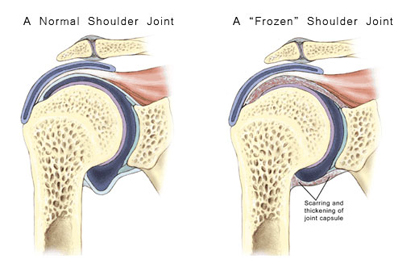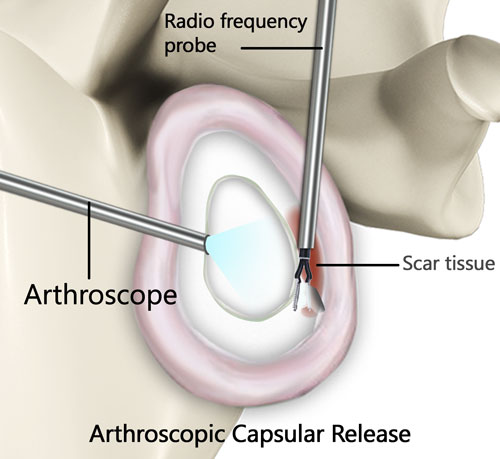Causes of Injury
A frozen shoulder, or adhesive capsulitis, is caused by thickening of the capsular wall surrounding the glenohumeral joint. This in turn creates adhesions and causes a decrease of synovial fluid. The reason why this develops is not always clear. It can be associated with a previous injury and being immobilized for a period of time or a diabetic association. It is unlikely to develop a frozen shoulder more than once in the same joint.

Diagnosis
To diagnose, Dr. Nicholson will examine the shoulder in the office. He will compare the contralateral side in range of motion and strength. He will then go through the patient’s medical history and current medications. For first time patients, he may have an x-ray taken at the appointment to rule out other pathologies, but an x-ray will not diagnose a frozen shoulder.
Symptoms that develop can be slow in progression with an increase of stiffness, pain and weakness with activities daily living. The onset can be without an injury and can start dull or achy for weeks to months.

Non-Operative Treatment
Conservative treatment begins with physical therapy and Dr. Nicholson’s stiffness protocol focusing on range of motion and isometric strengthening 2-3 days a week. Depending on medical history, he may recommend a course of oral steroids or NSAIDs to help with pain. He likes to see patients back every 4 weeks for 2 months to evaluate improvement. If the patient remains stiff without much relief of pain or an increase in range of motion, he may recommend surgical intervention.

Surgical Treatments
Dr. Nicholson will recommend an Arthroscopic Capsular Release to help relieve pain and stiffness caused by the frozen shoulder. This is a minimally invasive surgery using small tools to remove and cut the thickened, swollen or inflamed capsule adhesions. Dr. Nicholson has patients out of the sling in 3-5 days and beginning physical therapy in the first week following surgery, attending 3 days a week. He will follow up with the patient every 4 weeks to ensure the shoulder is improving in motion and pain. Patients are released to light duty between 6-8 weeks and full duty between 8-16 weeks. With hard work in physical therapy, patients can expect to regain full range of motion and strength.

